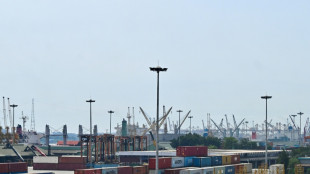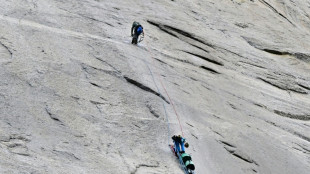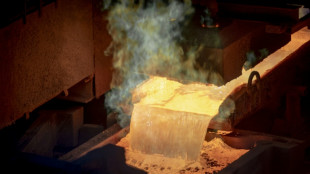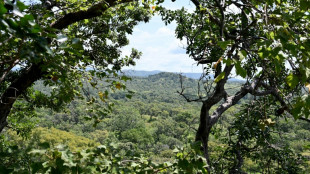
-
 Explorers seek ancient Antarctica ice in climate change study
Explorers seek ancient Antarctica ice in climate change study
-
India's Iyer discharged from hospital after lacerated spleen

-
 Serbia marks first anniversary of deadly train station collapse
Serbia marks first anniversary of deadly train station collapse
-
Latin America weathered Trump tariffs better than feared: regional bank chief

-
 Bangladesh dockers strike over foreign takeover of key port
Bangladesh dockers strike over foreign takeover of key port
-
Tanzania president wins election landslide after deadly protests

-
 Sixers suffer first loss, Bulls stay perfect as NBA Cup opens
Sixers suffer first loss, Bulls stay perfect as NBA Cup opens
-
Dodgers, Blue Jays gear up for winner-take-all World Series game seven

-
 Taiwan's new opposition leader against defence spending hike
Taiwan's new opposition leader against defence spending hike
-
China to exempt some Nexperia chips from export ban

-
 Dodgers hold off Blue Jays 3-1 to force World Series game seven
Dodgers hold off Blue Jays 3-1 to force World Series game seven
-
Crowns, beauty, fried chicken: Korean culture meets diplomacy at APEC

-
 Panama wins canal expansion arbitration against Spanish company
Panama wins canal expansion arbitration against Spanish company
-
Myanmar fireworks festival goers shun politics for tradition

-
 China to exempt some Nexperia orders from export ban
China to exempt some Nexperia orders from export ban
-
Sixers suffer first loss as NBA Cup begins

-
 China's Xi to meet South Korean leader, capping APEC summit
China's Xi to meet South Korean leader, capping APEC summit
-
Japan's Chiba leads after Skate Canada short program

-
 Finland's crackdown on undocumented migrants sparks fear
Finland's crackdown on undocumented migrants sparks fear
-
Climbers test limits at Yosemite, short-staffed by US shutdown

-
 Gstaad gives O'Brien record 21st Breeders' Cup win
Gstaad gives O'Brien record 21st Breeders' Cup win
-
After the tears, anger on Rio's blood-stained streets

-
 Sinner boosts number one bid in Paris, to face Zverev in semis
Sinner boosts number one bid in Paris, to face Zverev in semis
-
Springer back in Toronto lineup as Blue Jays try to close out Dodgers

-
 Nationals make Butera MLB's youngest manager since 1972
Nationals make Butera MLB's youngest manager since 1972
-
Guirassy lifts Dortmund past Augsburg ahead of Man City clash

-
 G7 says it's 'serious' about confronting China's critical mineral dominance
G7 says it's 'serious' about confronting China's critical mineral dominance
-
NFL fines Ravens $100,000 over Jackson injury status report

-
 NBA refs to start using headsets on Saturday
NBA refs to start using headsets on Saturday
-
Trump says Christians in Nigeria face 'existential threat'

-
 French-Turkish actor Tcheky Karyo dies at 72
French-Turkish actor Tcheky Karyo dies at 72
-
Food stamps, the bulwark against hunger for over 40 mn Americans

-
 Trump keeps world guessing with shock nuclear test order
Trump keeps world guessing with shock nuclear test order
-
Wall Street stocks rebound on Amazon, Apple earnings

-
 US Fed official backed rate pause because inflation 'too high'
US Fed official backed rate pause because inflation 'too high'
-
Prayers and anthems: welcome to the Trump-era Kennedy Center

-
 Swiss central bank profits boosted by gold price surge
Swiss central bank profits boosted by gold price surge
-
Sinner beats Shelton to boost number one bid in Paris

-
 French court jails Bulgarians for up to four years for Holocaust memorial defacement
French court jails Bulgarians for up to four years for Holocaust memorial defacement
-
Profits dip at ExxonMobil, Chevron on lower crude prices

-
 Ashraf and Mirza skittle South Africa as Pakistan win 2nd T20
Ashraf and Mirza skittle South Africa as Pakistan win 2nd T20
-
2,000 trucks stuck in Belarus after Lithuania closes border: association

-
 French lawmakers reject wealth tax proposal in budget debate
French lawmakers reject wealth tax proposal in budget debate
-
Premier League blames European expansion for lack of Boxing Day games

-
 Bublik sets up Auger-Aliassime semi-final at Paris Masters
Bublik sets up Auger-Aliassime semi-final at Paris Masters
-
World's most expensive coffee goes on sale in Dubai at $1,000 a cup

-
 Trump stirs global tensions, confusion with nuclear test order
Trump stirs global tensions, confusion with nuclear test order
-
Panic across US as health insurance costs set to surge

-
 Court eases ban on Russian lugers but Olympic hopes on thin ice
Court eases ban on Russian lugers but Olympic hopes on thin ice
-
England captain Itoje targets Autumn Nations clean sweep


Cook Islands wages war on 'plague' of hungry starfish
Divers clutch wooden spears as they plunge beneath the waves, hunting hordes of hungry starfish destroying the coral reefs around the Cook Islands.
These makeshift tools are their best weapons in the war against crown-of-thorns starfish, a coral-munching species eating through tropical reefs already weakened by climate change.
The Cook Islands, a South Pacific nation of about 17,000 people, is in the grips of a years-long outbreak, says marine biologist Teina Rongo.
"It can completely kill off the entire reef, right around the island," said Rongo, who organises volunteers protecting the reefs fringing the isle of Rarotonga.
"I think there seems to be a Pacific-wide outbreak at the moment, because we're hearing other countries are facing similar challenges."
A single crown-of-thorns adult can eat more than 10 square metres (110 square feet) of reef each year, squeezing its stomach through its mouth to coat coral in digestive juices.
They pose a major threat to Australia's Great Barrier Reef, where scientists have developed robots that hunt down the prickly invertebrates and inject them with poison.
"At the moment, you basically kill them by injection," said researcher Sven Uthicke, from the Australian Institute of Marine Science.
"It could be vinegar, it could be lime juice or ox bile.
"Others are building chemical attraction traps. It's all very promising -- but it's in the development stage."
Rongo finds it quickest to pry the feasting starfish loose using a wooden stick cut from the dense timber of the Pacific Ironwood tree.
"Basically, we use a stick with a hook at the end," he said.
"We've made some modifications over time because we were getting pricked by these starfish. It's painful."
Named for their hundreds of venomous spikes, crown-of-thorns starfish have as many as 21 fleshy arms and can grow larger than a car tyre.
They are typically found in such low numbers that they are not considered a problem.
But sporadically populations explode in a feeding frenzy that rapidly strips the life from reefs.
- 'Plague proportions ' -
They spawn in "plague proportions", according to the Australian Institute of Marine Science, and are a major driver of coral loss.
From the Red Sea to the Pacific Ocean, crown-of-thorns outbreaks appear to be becoming both more frequent and more severe.
"Some argue that the crown-of-thorns has become chronic in the last few decades," said Rongo, talking about the reefs of the South Pacific.
Scientists suspect these outbreaks are triggered by a mix of factors, including nutrients leached into the sea from agriculture and fluctuations in natural predators.
But the damage they can cause is getting worse as reefs are weakened by climate change-fuelled coral bleaching and ocean acidification.
"This is why it's important for us to help the reef," says Rongo.
Scuba divers scour the Cook Islands' reefs for hard-to-spot starfish wedged into dimly lit crevices.
Once peeled off the coral, the starfish are pierced with a thick rope so they can be dragged back up to a waiting boat.
The day's haul is dumped into a plastic chest before the starfish are lugged ashore to be counted, measured and mulched for garden fertiliser.
They are known as "taramea" in Cook Islands Maori, which loosely translates to "spiky thing".
The volunteer divers working with Rongo and his environmental group Korero O Te Orau -- or Knowledge of the Land, Sky and Sea -- remove thousands of starfish every year.
Rongo is spurred by the devastation from the nation's last major infestation in the 1990s.
"I was part of that eradication effort.
"We were too late when we did decide to do something about it. It went on and ended up killing the reef."
F.AbuZaid--SF-PST




